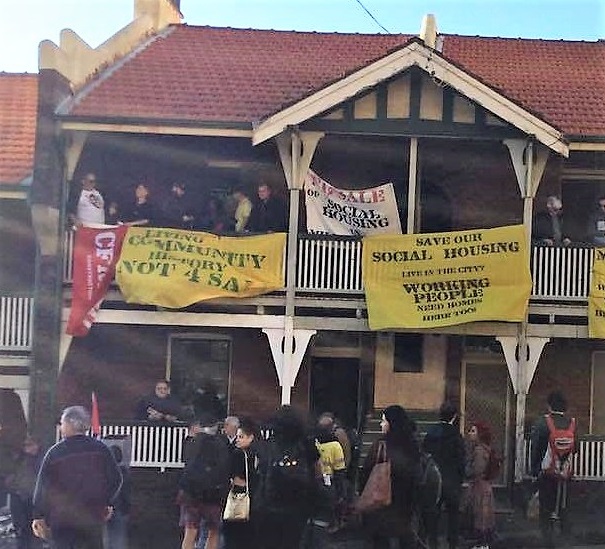Photo Above: Six years ago, scores of current and former public housing tenants, trade unionists from the Maritime Union of Australia, Trotskyist Platform supporters, staunch anti-fascist activists and other supporters of public housing carried out a powerful occupation of vacant public housing dwellings at 78 to 80 High St, in inner city Sydney’s Millers Point to oppose the slated sell-off of these properties to wealthy speculators and capitalist developers. The powerful 6 August 2017 occupation demanded that these vacant public housing dwellings be made available to those on the public housing waiting list or the homeless. We urgently need such actions now on a huge scale to not only oppose all privatisation of public housing but to fight for the confiscation of the vacant homes of the ultra-rich so that they can be used for low-rent public housing.
Drive Down Rents by
Massively Increasing Public Housing!
Expand Rental Supply Now –
Confiscate Vacant Houses of the Ultra-Rich!
16 June 2023: Skyrocketing rents in Australia are driving working class people into poverty. Over the last year, rents for new leases surged by an incredible 20% in capital cities. Alongside the prices of food, electricity and fuel rising much more quickly than modest wage increases, surging rents are forcing millions of people to skip meals, stop buying fresh food, forego visits to dentists and specialists and avoid using heaters during the frigid winter, just to try and get by.
Unaffordable rents are the result of the capitalist “free market”. Developers shy away from building affordable homes because they know that they can make more profit by building expensive homes for the affluent or for wealthy investors looking to buy up houses for speculation. As a result, there is such a shortage of affordable rentals that not only are landlords able to jack up rents but low income tenants are not able to move into cheaper homes to escape soaring rents in their existing tenancies. A recent rental affordability snapshot found that just eight out of every 1000 available properties were affordable for a single person on the minimum wage lucky enough to have a full-time job! At the time of the 2021 census, over 122,000 people were homeless in Australia. Since then, the number of homeless people has skyrocketed – many of whom have jobs. Meanwhile, more and more low income women who are financially dependent on abusive partners are being hit with the terrible “choice” of either dumping their abusers and becoming homeless or trying to endure the abuse just to keep a roof over their – and often their children’s – heads.
The inevitable failure of profit-driven developers to provide affordable accommodation is compounded by the policies of federal and state governments. Not only have they favoured landlords and investors over low income tenants, they have instituted tax policies that have skewed the housing market towards speculators. Most damagingly, these governments have gutted public housing. As a result, the percentage of people in public housing in Australia has nearly halved over the last 25 years! By 2021, the proportion of public housing had plunged to just one in every 36 dwellings.
Some of the public housing sold off by governments has been turned into “community housing”. Still, over the last 25 years, Australia’s governments have slashed the total amount of “social housing” – which includes both public and “community” housing – by a quarter. Moreover, “community housing” is not public housing. “Community housing” landlords are private entities notorious for their high-handed bullying of tenants. Furthermore, because “community housing” operators are driven to either make a profit or, if they are a charity, “break even”, they bias their tenancy allocation towards those who can afford higher rents. Thus, the proportion of well-off people housed in “community housing” is nearly three times higher than in “public housing.” On average, “community housing” operators allocate one in eight tenancies to those who are in the highest 60% of income earners – many low income households thus missing out when public housing is converted into “community housing”. Moreover, the proportion of community housing” that is tenanted by Aboriginal and Torres Strait Islander people is 20% lower than in public housing. We say: No to privatisation by stealth – Stop the sell-off of public housing to private “community housing” operators!
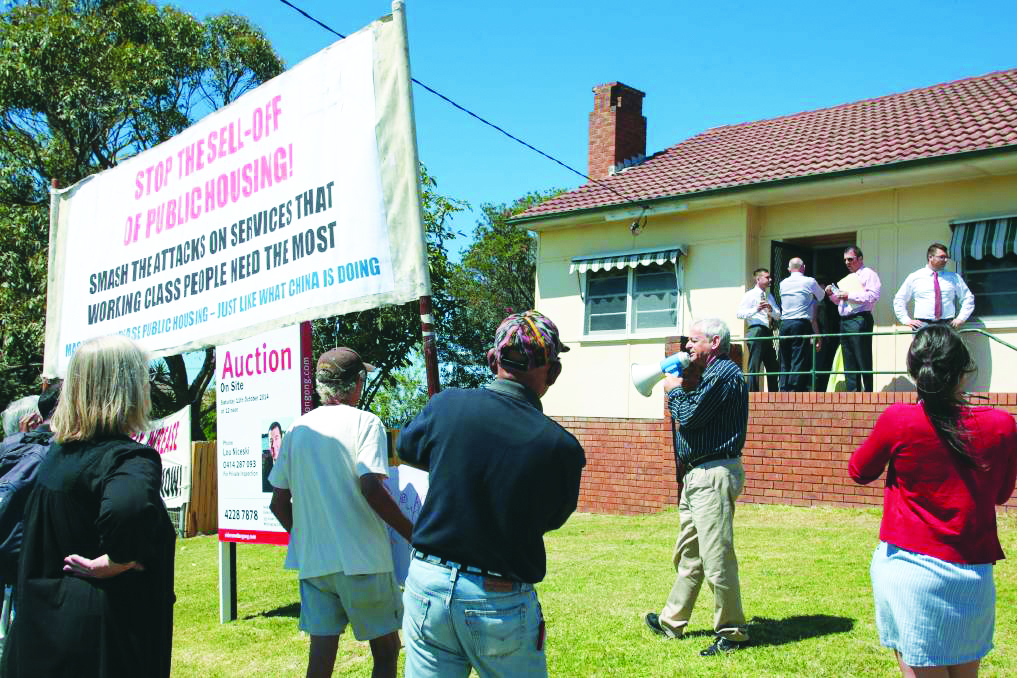
Photo credit: Adam McLean
What is needed is to massively increase the amount of low-rent public housing. This does not only mean greatly boosting the public housing budget. Currently, at every level, capitalist contractors engaged to build and maintain public housing leach off as profit a big part of housing budgets. State-owned firms must be set up to take over these tasks so that more public housing can be built for the same spending. However, all this alone will no longer be able to relieve the hardships of those hit by soaring private rents. Not only is the public housing waiting list too huge, many others eligible have not put their names on the list only because they know about the ten plus years they may need to wait to finally get a tenancy. Moreover, the criteria to even get on the list is so stringent that many who desperately need public housing can’t even get wait listed. Thus, a full-time, minimum wage worker is not even close to being eligible for public housing. To immediately boost the supply of public housing, some of the more than one million unoccupied homes (!) in Australia must be requisitioned. Many of them are owned by the super-rich who use them as holiday homes or as speculative investments. We say that any dwelling owned by a household with more than five million dollars worth of property assets that is either unoccupied or underutilised for one month – or for a total of more than two months within a year – should be confiscated and turned into public housing. Since such dwellings are often large mansions, they can be turned into dwellings for multiple households. And to the extent that the ultra-rich will let out their properties to avoid such confiscation that will, at least, reduce the demand – and hence rents – for other dwellings.
For Working Class Protest Action to Win Low-Rent Housing for the Masses
To institute the housing measures that are urgently needed, it is not only the right wing Liberals that stand in the way. All the parties currently in parliament are complicit in undermining public housing. In just the five years up to 2021, the state Labor government in Victoria slashed the proportion of public housing dwellings there by nearly 14%. For their part, the Greens, in a coalition with Labor in Tasmania in the early 2010s, were part of a state government that drastically cut the proportion of public housing dwellings, alongside slashing public housing maintenance.

Photo credit: Trotskyist Platform
Today, with a widely acknowledged rental affordability crisis, the ALP and the Greens are now keen to portray themselves as supporters of “social housing”. Labor promises 30,000 new “social and affordable” housing dwellings over five years. However, the new “social housing” will not be public housing but “community housing”. The “affordable housing” component involves subsidising landlords to offer rents 20% lower than the market rate. Yet with market rents so obscenely high, such “affordable” homes will remain out of reach for most low-paid workers and part-time workers, let alone unemployed workers and students. Moreover, as the Greens have rightly pointed out, the 30,000 “social and affordable” dwellings that Labor pledges, will not even meet half the increased need for low-rent accommodation during the next five years. The ALP’s plan is a recipe for driving even more low income renters into poverty – albeit at a slightly slower pace! The Greens plan offers more, promising $2.5 billion a year on low-rent housing. However, this is still wholly inadequate to address the huge shortfall in low-rent accommodation. This is especially so given that the Greens, as a party which accepts the dominance of the capitalist economy, has no plan for bringing the actual construction and maintenance of public housing under public ownership, thus allowing a big chunk of the housing budget to continue to be gouged away by the bosses of capitalist contracting firms. Moreover, the Greens plan is not exclusively for public housing but also for “community” and “affordable” housing. Thus, in good part, the Green’s proposals, like the ALP government’s entire plan, will see public money handed over to private landlords – money that should be used to build up public housing. The Greens do call for a freeze on rents – a measure that we support. However, such rent controls will only work if they are accompanied by measures to restrict landlords from removing properties from the rental market and skimping on repairs – measures that the Greens do not advocate. Most notably, the Greens do not even promise the housing measure that is most urgently needed: the confiscation of the vacant homes of the ultra-rich and their transfer into the public housing stock.
Ultimately, all the current parliamentary parties have no program that can truly solve the rental and homelessness crisis because they all uphold the big end of town’s “right to dispose of their property as they see fit”. To win the housing measures needed, workers, unemployed workers, low income youth, activists opposing domestic violence against women and leftists must all unite in militant protest action. There need to be mass protest occupations to stop any privatisation of public housing and to requisition the vacant homes of the super-rich into the public housing supply. In recent years there have been some actions that can inspire us on this course. On 6 August 2017, scores of current and former public housing tenants, trade unionists from the Maritime Union of Australia, Trotskyist Platform supporters and staunch anti-fascist activists carried out a powerful occupation of vacant public housing dwellings at 78 to 80 High St, in inner city Sydney’s Millers Point to oppose the slated sell-off of these properties to wealthy speculators and capitalist developers. Although after about five hours, van loads of riot police brutally broke up the action and arrested four of the activists involved, including two main organisers of the occupation – a respected long-time Millers Point tenant who had then recently been cruelly evicted from public housing there and one of our own Trotskyist Platform comrades – the action scared the then NSW Coalition government enough to temporarily restrain their broader state-wide public housing selloff. This can be seen by looking at the numbers of public housing dwellings in NSW over the last decade (see Table 18A.3, Report on Government Services 2022, Australian Government Productivity Commission). They show that during each year, the number of public housing dwellings either decreased or barely changed. The one exception is for the financial year that includes the eleven month period that followed the August 2017 Millers Point occupation – when total public housing numbers in NSW increased by over 1,100 homes. Then just last week, about two dozen people occupied the common areas of a public housing block in 82 Wentworth Park Rd, Glebe to oppose the NSW state government’s plan to demolish the block and turn the site into a larger “mixed” housing block with the public housing turned into privately-run “community housing”. The protest action, which was deemed legal by the authorities because none of the vacant units were occupied, lasted five days. It was organised by Action for Public Housing and the Anti-Poverty Centre and was supported by various socialist groups as well as by left-wing anarchists and other staunch antifascists who did much of the hard work of staffing the protest site during the nights. The action had an impact. The housing minister in the new NSW state Labor government has now promised that the site will remain entirely devoted to public housing (but without any evidence of an actual change to the formal development plan activists are rightly sceptical of this promise).
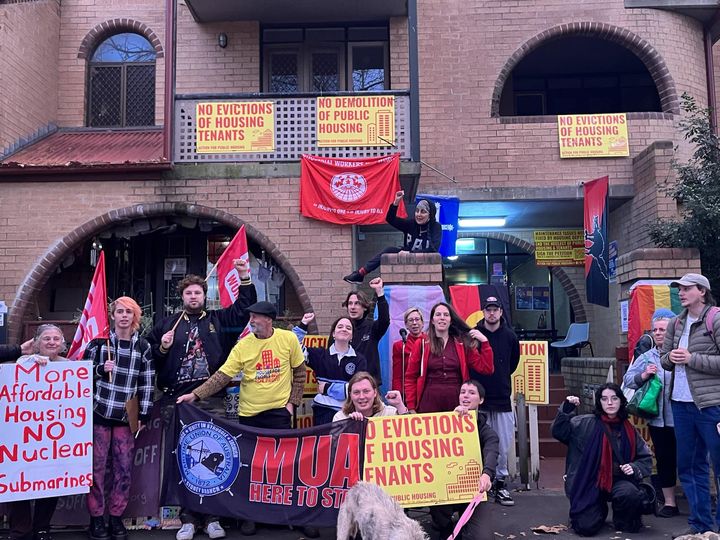
Photo Credit: Action For Public Housing Facebook page
Yet, given the severity of the long-brewing rental affordability crisis, we need mass action on a scale and intensity much greater than anything we have seen. In particular, the power of the organised working class movement must be brought to bear. Class-struggle action to win the measures needed to provide low-rent accommodation must be combined with demands for a big increase in workers’ wages, for the conversion of casual jobs into secure ones with all the rights of permanency and for the confiscation of the power and fuel sectors and their transfer into public hands in order to drive down unaffordable living costs. To unleash the kind of struggle needed, it is not enough to energetically advocate for it. We must knock down the political obstacles that stand in the way of such struggle. Chief among these is the reality that the current leadership of the workers movement are supporters of the ALP. Especially with an ALP federal government and wall to wall Labor state governments across the mainland, they are reluctant to organise truly concerted struggle against any government policy. Instead, they tell their working class base that the ALP in office is the best that they can hope for and nothing should be done that could damage the ALP’s re-election prospects. These officials sell their ranks the lie that the ALP’s program of seeking “win-win” collaboration with the big end of town is workers’ only effective path to improving their lives. Currently, many workers grudgingly accept these claims. That is why, the struggle to mobilise determined action against soaring rents must be accompanied by a political campaign to explain that, when in government, the ALP, in the end, operates a state machine hard wired to the capitalists that is programmed to serve the big business and big property owners. In opposition to the program of the Labourites, we must win the most politically advanced workers to the understanding that the interests of working class people can only advance at the expense of the economic interests of the capitalist big-end-of-town.
Hopes in the Greens are also an obstacle to the struggle that is needed. Since the Greens do at least loudly advocate for public housing, such illusions in the Greens do exist – especially amongst progressive-minded youth. Should the Greens want to support a particular protest action in defence of public housing, they are of course free to do so. However, activists must point out not only the Greens’ own tarnished record on public housing when they have been in coalition government with the ALP in Tasmania and federally in the early 2010s but the fact that this is inevitable for any party that seeks to manage the capitalist order. Most importantly, the demands and direction of struggles must not be curtailed to win the acceptance of the Greens. We must not shy away from militant protest occupations that impinge on official capitalist “property rights” or recoil from raising the urgently needed demand to confiscate the vacant homes of the ultra-rich because we know that both these courses will scare off the Greens, who after all include wealthy capitalists amongst their ranks and their donors as well as plenty of upper middle-class, multiple property owners. Just as importantly, we must not avoid openly framing our housing struggle as one that is being waged in the class interests of working class people against the class interests of the super-rich, big property-owning class for fear of “putting off the Greens”. If we were to in this way dilute and shroud the class-struggle content of our movement it would make the movement less attractive to militant workers – the very people whose participation is key to winning victories. For the movement against unaffordable rents to acquire the pro-working class orientation, militant character and anti-capitalist demands that can make it a serious factor, the movement must be freed from all subordination to the agenda of the “progressive” wing of the big end of town, represented by the Greens. All promotion of the Greens by groups within the movement – for example, by advocacy of a vote for the Greens at elections – must be challenged.
There is another, very sinister, political challenge that faces any movement to drive down unaffordable rents. That is the fact that the capitalist class, including most blatantly the capitalist media and Peter Dutton’s Liberal Party, are increasingly seeking to blame migration for the rental affordability crisis. Their claims are a complete pack of lies. The lack of affordable accommodation is solely the result of the capitalist free market in housing and decades of government policy favouring landlords and speculative investors over tenants and low income home buyers. The ruling class wants the masses to blame anyone but themselves! We cannot let them get away with this! To the extent that the masses buy the capitalist rulers’ propaganda, it will not only divert away the movement against unaffordable rents but by inciting racist hostility to migrants and people of colour, it will divide and weaken the workers movement and its capacity to resist capitalist attacks on its living standards. That is why the workers movement and all supporters of public housing must not only oppose any scapegoating of migrants for the housing crisis but must positively mobilise to defend targeted communities against any racist, and other bigoted, attacks. We must demand freedom for and the bringing here of all refugees from PNG and Nauru. We must build mass action to defend Aboriginal people, Asians, other people of colour and the LGBTIQ community against violent far-right forces. And to stop people, vulnerable because of their insecure visa status, being especially ripped off by greedy landlords, which helps push up rents for everyone, we must fight to win the full rights of citizenship for all visa workers, international students and refugees.
The Example of Socialistic China’s Housing Policy:
“Houses Are for Living, Not for Speculation”
Those opposing an emphasis on public housing and strict controls on the housing market argue that such an agenda does not work in practice. They say it is outdated and goes against the world trend of privatisation, “user-pays” and neo-liberal deregulation. There is a huge problem with that argument, however. In Australia’s largest trading partner, the People’s Republic of China (PRC), the direction over the last decade and a half has been explicitly towards public housing and strict regulation of the housing sector. In the decade from 2008, the PRC provided 70 million additional public housing dwellings for her low and lower-middle income people. Proportionate to population size, China delivered in ten years, one and a half times the amount of public housing as what the Greens promise to provide in low-cost accommodation over twenty years. As a result, today, the percentage of China’s urban population in public housing is nearly ten times higher than Australia’s. Moreover, the PRC’s public housing drive continues. Last year, the PRC provided an additional two and a half million public rental dwellings for her people. In percentage terms, this is equivalent to 45,000 dwellings here. That means proportionate to population size, Red China in just one year provided one and a half times as much public housing as what the Albanese government promises to deliver in privately-owned “social and affordable” housing over five years. And unlike here, China does not have a homelessness crisis. Despite China (which is still trying to pull herself up from her impoverished pre-1949, capitalist days) having a per capita income some three to five times lower than Australia’s, Chinese international students entering Australia, the U.S. and Western Europe are shocked at the level of homelessness in these richer countries compared with their socialistic homeland.
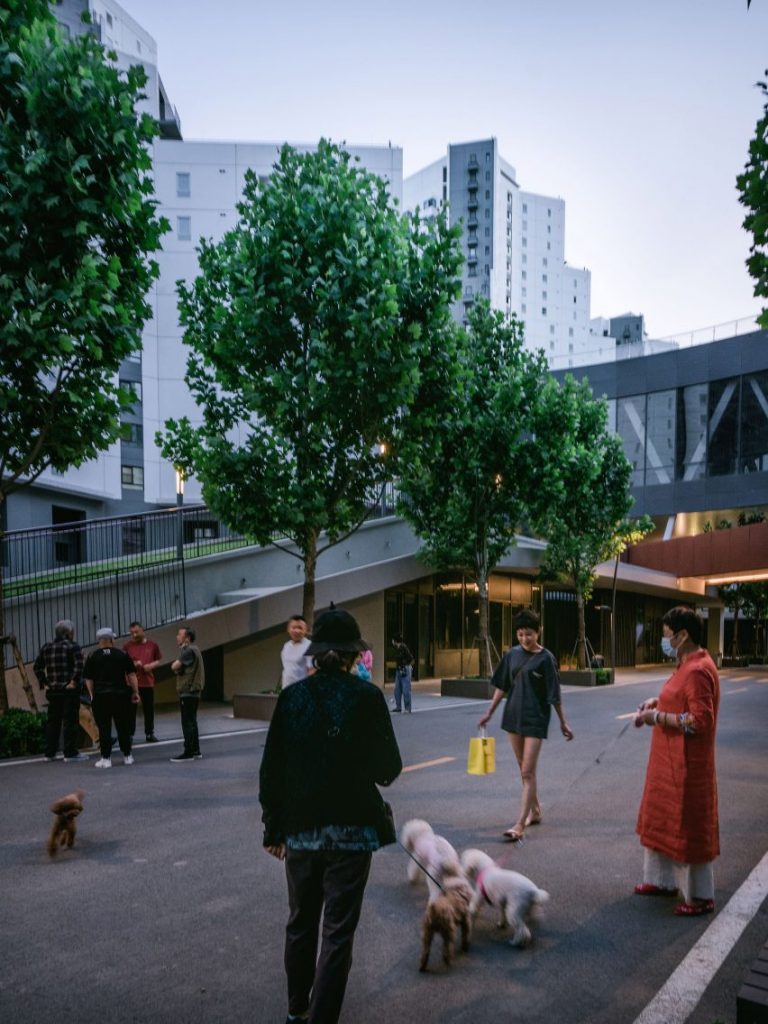
Photo credit: Zhu Yumeng
The PRC’s public housing drive is part of Beijing’s official housing policy that is aptly titled; “Houses are for living, not for speculation.” The PRC takes the opposite stance towards housing speculation compared to successive Australian governments. For example, most Chinese cities ban households from buying more than two homes. Needless to say, Australia’s big end of town hate the PRC’s policies. That is why their media seek to denigrate it at every possible instance. Last year, they seized on the troubles of a Chinese capitalist developer hit by the anti-speculation campaign to claim that the PRC’s “Houses are for living, not for speculation”-policy was soon going to cause the Chinese economy to collapse. Needless to say, that never happened! Today, while the capitalist Australian, American, British and German economies are either in recession or on the verge of one, the PRC’s economy surged by 4.5% last quarter. More importantly, socialistic China’s workers continue to enjoy, by far, the world’s fastest growth rate in real wages. All this is why the Western capitalist powers see China as an “existential threat.” They fear that the successes of China’ socialist alternative will encourage their own masses to also demand a system that puts the masses’ needs above big end of town profits. Frankly, that is the kind of “threat” that working class people in the capitalist West need! Let’s help “infect” Australia’s working class population with sympathy for Red China’s “Houses are for living, not for speculation” policy and her system that underpins it. The fact that China’s transition to socialism is incomplete, bureaucratically distorted and endangered by hostile elements – including by the capitalist powers internationally and by its own capitalists who long to have the right to “freely” exploit as in “normal” (that is capitalist) countries and who have a layer of academics, lawyers, journalists and politicians in the right wing of the ruling Communist Party of China doing their bidding – actually makes socialistic rule in China more in need of defence, not less. Let’s oppose the U.S. and Australian regime’s military build up against the PRC! Let’s refute their lying propaganda attacks against China! And let’s oppose the anticommunist groups within China that they support in their quest to destroy socialistic rule there!
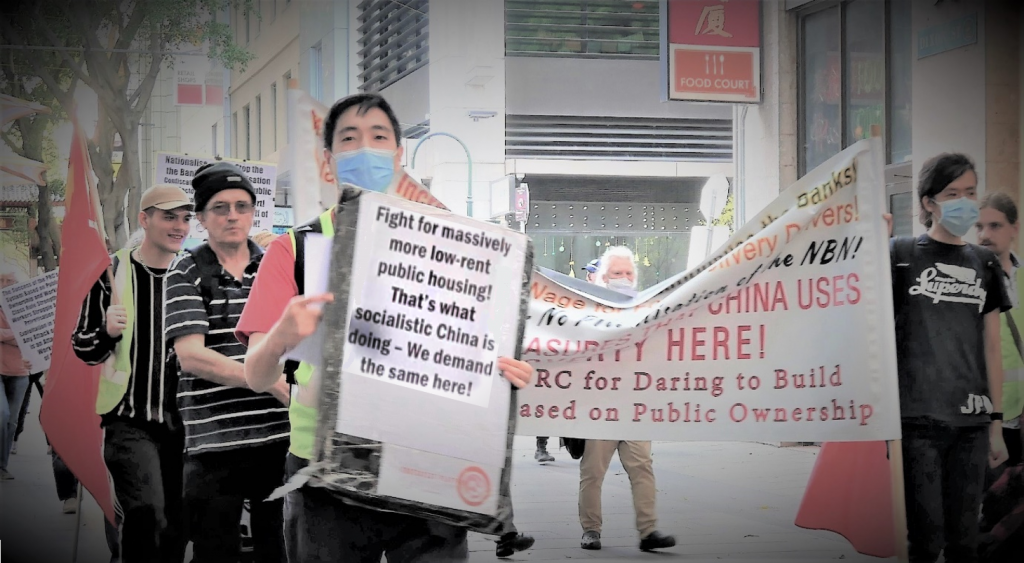
Photo credit: Demi Huang/New Impressions Media
The PRC’s public housing drive has been made possible not only by official policy. It is also made possible by the fact that the developers building the public housing, the steel, cement, glass and other factories providing the materials for the constructions and the banks whose loans provided part of the finance for the projects are all, overwhelmingly, under public ownership. So the PRC is able to build more public housing without having a good part of the budget leached away by capitalist profiteers. China’s system centred on public ownership was created in an inspirational revolution in 1949 that brought the toiling classes to power – albeit a power administered in an imperfect, indirect way via a middle-class bureaucracy. To ensure a system here where not only housing but also health care, aged care, education, industry, agriculture, science and culture operate for the people’s needs and not the profits of a super-rich few, the working class here will also need to take power. Let’s advance towards that goal by enhancing working class peoples’ unity, confidence in their own power and distrust of all the parties and institutions serving the capitalist class (and all its wings) in the course of hard-fought struggles to radically drive down rents, stop the plunge in the masses’ living standards and reverse the decline in workers’ real wages. Let’s build militant struggles to win a massive increase in public housing and the confiscation of the vacant homes of the ultra-rich for transfer into low-rent housing.
